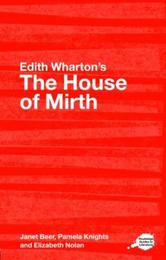
|
Edith Wharton's "The House of Mirth": A Routledge Study Guide
Paperback
Main Details
| Title |
Edith Wharton's "The House of Mirth": A Routledge Study Guide
|
| Authors and Contributors |
By (author) Janet Beer
|
|
By (author) Elizabeth Nolan
|
|
By (author) Pamela Knights
|
| Series | Routledge Guides to Literature |
|---|
| Physical Properties |
| Format:Paperback | | Pages:184 | | Dimensions(mm): Height 216,Width 138 |
|
| Category/Genre | Literature - history and criticism |
|---|
| ISBN/Barcode |
9780415350105
|
| Classifications | Dewey:813.52 |
|---|
| Audience | |
|---|
| Illustrations |
Illustrations
|
|
Publishing Details |
| Publisher |
Taylor & Francis Ltd
|
| Imprint |
Routledge
|
| Publication Date |
30 September 2006 |
| Publication Country |
United Kingdom
|
Description
Edith Wharton's The House of Mirth (1905) is a sharp and satirical, but also sensitive and tragic analysis of a young, single woman trying to find her place in a materialistic and unforgiving society. The House of Mirth offers a fascinating insight into the culture of the time and, as suggested by the success of recent film adaptations, it is also an enduring tale of love, ambition and social pressures still relevant today. Including a selection of illustrations from the original magazine publication, which offers a unique insight to what the contemporary reader would have seen, this volume also provides: an accessible introduction to the text and contexts of The House of Mirth a critical history, surveying the many interpretations of the text from publication to the present a selection of new critical essays on the The House of Mirth, by Edie Thornton, Katherine Joslin, Janet Beer, Elizabeth Nolan, Kathy Fedorko and Pamela Knights, providing a range of perspectives on the novel and extending the coverage of key critical approaches identified in the survey section cross-references between sections of the guide, in order to suggest links between texts, contexts and criticism suggestions for further reading. Part of the Routledge Guides to Literature series, this volume is essential reading for all those beginning detailed study of The House of Mirth and seeking not only a guide to the novel, but a way through the wealth of contextual and critical material that surrounds Wharton's text.
|